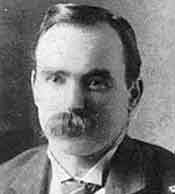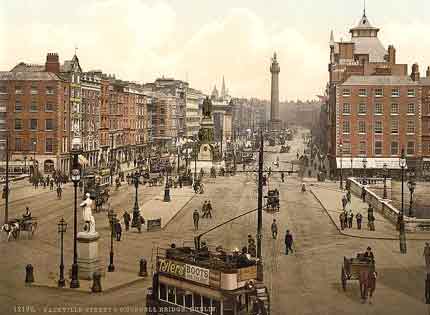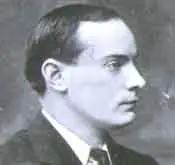In 1916 on Easter Monday, 150 men walked out of the Liberty Hall trade union headquarters in Dublin and then marched their way into history. They were drawn from a number of groups including the Irish the Republican Brotherhood, the Irish Volunteer Force and the Irish Citizens Army.
They were not very well trained and they were even less well armed but they were ready to take on the might of the British Army. Their actions were to transform Ireland for ever. At the head of this motley force were Patrick Pearse of the Irish Republican Brotherhood (IRB), and James Connolly of the Transport and General Workers Union. Pearse and Connolly were members of the the IRB’s Military Council that planned the Easter Rising. The other five members were Tom Clarke, Seán MacDiarmada, Thomas MacDonagh, Éamonn Ceannt and Joseph Plunkett. Plunkett was recovering from an operation and was so weak that he had to be helped to walk by his assistants, one of whom was Michael Collins.
Once outside, the leaders of the Rising the leaders met with hundreds of other rebels who had assembled at Liberty Hall to take part in the Rising.
 The plan was to split up into several groups and take control of key buildings throughout Dublin and proclaim an independent republic. The rebels were made up mainly of members of the Irish Volunteers and and Irish Citizen Army (ICA). They didn’t attract much attention as they marched, either from the authorities or from the people of Dublin. It was normal for them to train in public and so no one paid them much attention. The group led by Pearse and Connolly were marching the few hundred yards from the appropriately named Liberty Hall, the transport union’s headquarters, to Dublin’s General Post Office (GPO) building.
The plan was to split up into several groups and take control of key buildings throughout Dublin and proclaim an independent republic. The rebels were made up mainly of members of the Irish Volunteers and and Irish Citizen Army (ICA). They didn’t attract much attention as they marched, either from the authorities or from the people of Dublin. It was normal for them to train in public and so no one paid them much attention. The group led by Pearse and Connolly were marching the few hundred yards from the appropriately named Liberty Hall, the transport union’s headquarters, to Dublin’s General Post Office (GPO) building.
When they arrived outside the GPO on Sackville Street (later renamed as O’Connell Street). Connolly suddenly gave the order to charge and his troops stormed the building. They quickly took control.

The Proclamation of Irish Independence
Once inside they took down the British Union Flag and replaced it with two others: one was a plain green flag with the inscription, Irish Republic, and the other was the tricolour of green, white and orange that would later become Ireland’s national flag.
 Patrick Pearse then read the Proclamation of the Irish Republic, declaring that they were now the Provisional Government of a new independent Ireland. It was a momentous occasion but at the time it meant little to the bemused onlookers who couldn’t quite make out what was going on.
Patrick Pearse then read the Proclamation of the Irish Republic, declaring that they were now the Provisional Government of a new independent Ireland. It was a momentous occasion but at the time it meant little to the bemused onlookers who couldn’t quite make out what was going on.
After taking over the GPO, the rebels set about fortifying their position as best they could as they waited for the British authorities to respond. The first thing they did was break the windows so they would not be injured by glass once the British started to fire at them. The also broke through exterior walls to make a passageway through to neighbouring buildings, enabling them to cover much of the steet without having to put themselves at risk by moving outside. Other rebels started to build barricades on Sackville Street.
The key sites in the Easter Rising
Meanwhile, other groups of rebels were taking over other key targets.They chose sites that enabled them to control the centre of the city and were easy to defend. These are the main centres.
General Post Office (GPO) This was the main headquarters of the Provisional Government. Five of the seven members of the Military Council were stationed in the GPO – Patrick Pearse, James Connolly, Seán MacDiarmada, James Plunkett and Tom Clarke. The rebels eventually had to abandon the building as it caught fire under heavy bombardment. They set up new headquarters at nearby Moore Street, where the decision was taken to surrender to avoid further loss of life.
Four Courts – situated about a mile to the west of the GPO. It was stratefically important because it overlooked the main route from the British military barracks to the GPO. The First Battalion of the Dublin Brigade of the Volunteeers were stationed here under the command of Edward Daly. Streets around the Four Courts saw some of the worst fighting and several civilians were killed in the crossfire. Daly is reported to have taken over a nearby bakery and distributed bread to local people.
South Dublin Union – a collection of buildings including a former poor house on the site of what is now St James’ Hospital. Éamonn Ceannt was the commander of the 4th Battalion of the Dublin Brigade who were involved in some of fiercest fighting, including an heroic rearguard display by Cathal Brugha who, although badly wounded, defended a barricade single-handledly for two hours until hours reinforcements arrived.
Boland’s Bakery/Mill – the 3rd Battalion of the Volunteers were stationed here led by Éamon de Valera, who would later become President of Ireland. The site was important because it controlled the rail line and main road from Kingstown (now Dun Laoghaire), the routes likely to be used by British troops into the city.
Mount Street Bridge – this was part of de Valera’s command and the scene of what has been described as Ireland’s Battle of the Alamo – in which a handful of Volunteers commanded by George Reynolds inflicted the worst casualties of the conflict on British troops marching from Dun Laoghaire into the city. They held out for five hours until they were out of ammunition. The British then retook the bridge but more than 200 of their soldiers were killed or wounded in the process.
Jacob’s Biscuit Factory – on Bishop Street about a mile from the GPO. The 2nd battalion of the Volunteers were stationed here under the command of Thomas MacDonagh and Major John MacBride, who had been married to Maud Gonne. The building is now the home of the National Archives. Among the Volunteers stationed there was Peadar Kearney, who went on to write the lyrics to the national anthem, Amhrán na bhFiann.
Mendicity Institute – a poor house on the Dublin quays. It was manned mainly by little more than boy soldiers led by the youthful Captain Seán Heuston, who was part of Commandant Daly’s 1st Battalion. It was taken to control the route between the Royal Barracks and the Four Courts. Heuston and his team were asked to try to delay the advance of British soldiers on the Four Courts by a few hours until the rebels there were settled in. In the end, Heuston and his 13-strong team held out for three days. Following their surrender,the hardened British troops were astonished that they had been held back so long by such a small and youthful team.
St Stephen’s Green/Royal College of Surgeons – members of the Irish Citizen Army took up position here under the command of Michael Mallin and his second in command, the Countess Markiewicz. The fighting was less intense here as the British concentrated their efforts on more important sites such as the GPO and the Four Courts. The Green produced one of the Easter Rising’s more surreal stories of how both sides called a truce for a few minutes each day to allow the park keeper to feed the ducks. Once the ducks were fed, hostilities could begin again.
The Easter Rising had been planned by the Military Council of the Irish Republican Brotherhood. They hoped that the British would be pre-occupied with the Great War in Europe and so would not be able to respond with the same speed and force as they would in peacetime.
This turned out to be a miscalculation. It was true that the British were heavily committed in Europe, but they could still muster far more firepower than the rebels and moved quickly to suppress the Rising.
easter-rising.html